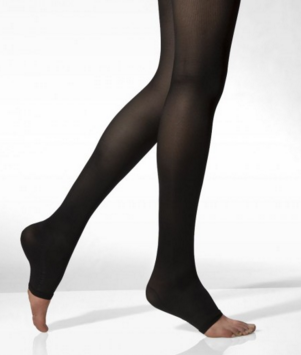Compression garments are a common treatment for individuals with POTS, but why are they recommended, and how exactly do they work?
What happens when you stand up?
When a person stands up, gravity pulls blood from the upper chest down into the abdomen and legs. As a result, there is less blood getting back to the heart. This is a problem because the heart is not able to pump blood as effectively to the body. The body detects these changes and activates the “fight or flight” response, or sympathetic branch of the autonomic nervous system, to increase heart rate and squeeze the blood vessels in the body to help blood get back to the heart.
When a healthy person stands up, they may experience a brief increase in heart rate, or decrease in blood pressure, but this usually isn’t noticeable because the body quickly adapts to the positional change. However, in a person with POTS, the body’s ability to regulate this response to standing is disrupted. An abnormal amount of blood collects, or pools, in the abdomen and legs, and blood does not get back to the heart very efficiently. This leads to unpleasant and common POTS symptoms including lightheadedness, dizziness, shaking, chest pain and nausea.
How can compression garments help?
The body’s response to standing is where the theory of compression garments comes into play. In a healthy person, when the sympathetic nervous system is activated, blood vessels in the body squeeze to get blood back to the heart. However, in individuals with POTS we think there is still too much blood that is collecting in the abdomen and legs and not getting back to the heart. What if we could intervene and mimic the squeezing of blood vessels with an external garment? If we can provide mechanical squeezing to the abdomen and lower body, helping blood get back to the heart, then the heart doesn’t have to work as hard. Compression garments do just this. When applied to the body, they exert a force which pumps the pooled blood in the legs and abdomen back up to the heart. Once the heart is getting enough blood, it doesn’t have to beat as fast to try and keep up with the body’s demands. The sympathetic nervous system reduces its activity and heart rate slows down.
POTS and Compression Garment Research :
Although compression garments are commonly prescribed for people with POTS, there is no research in an adult POTS population demonstrating how they work, and as well, which type of garment is best to manage POTS symptoms and lower heart rate. Compression garments vary in terms of the strength of compression (measured in mmHg) and style, including socks, shorts and waist high tights.
I am currently conducting a clinical trial to understand more about how compression garments work. This research is studying the use of compression garments in POTS to help minimize blood pooling, and in turn lower heart rate and symptoms. I am using a non-inflatable lower body compression garment made of neoprene and Velcro, like a wetsuit. This garment can be done up in different segments compressing all or part of the lower body. This garment serves as a good model compression garment for research because of the segments, and because multiple people of different sizes can wear the same garment. However, it isn’t something a POTS patient would wear in real life. Instead, we can translate the research findings from this garment to actual commercial garments like socks, shorts or waist-high tights.
In this study, I use a head up tilt table test to simulate standing. When held upright on a tilt-table, the leg muscles that would normally help blood get back to their heart, are not engaged. With this, we are measuring the body’s ability to manage standing without the leg muscle pump, as well as the action of the compression garments on the body. During my study, the participants wear the compression garment done up in 4 different configurations for 10 minutes each, for a total of 4 tilt table tests. The 4 configurations are: no garment, lower leg only (like a compression sock), upper leg/abdomen only (like compression shorts) and full lower body compression (like waist-high tights).
During the tilt table tests, I measure participants’ blood pressure, heart rate and symptom scores both lying down and upright. From this data we can calculate how blood is flowing through the heart and blood vessels, which helps us understand how the body is responding to standing. I am also measuring blood flow to the brain using ultrasound to determine whether or not compression garments affect blood flow to the brain, in addition to their possible heart rate and symptom effects.
Once this study is complete, we will be able to demonstrate whether or not compression garments are effective at lowering heart rate and improving symptoms in individuals with POTS and as well, if effective, which style/type of garment is best. These findings can be used to help doctors recommend the best type of compression for management of POTS symptoms. It may also provide evidence to aid in receiving insurance coverage for these garments.
Guest author, Kate Bourne, B.Sc., is a Cardiac Science Graduate student in Dr. Satish Raj’s Lab at the University of Calgary in Alberta, Canada.

